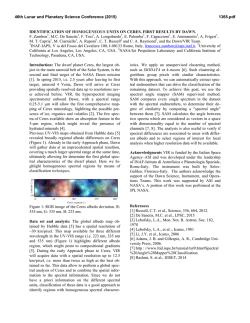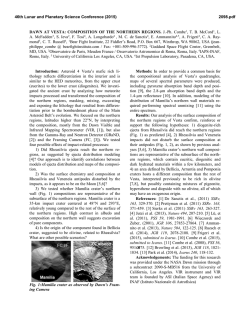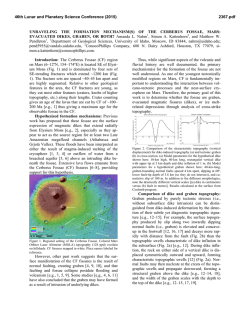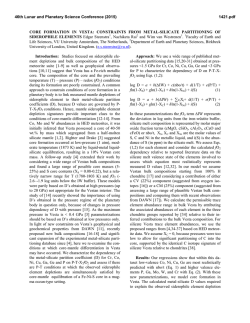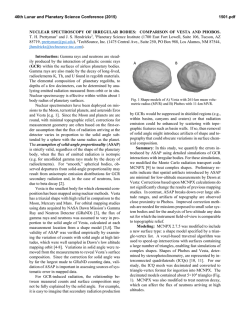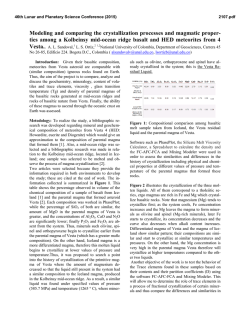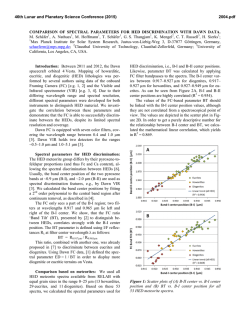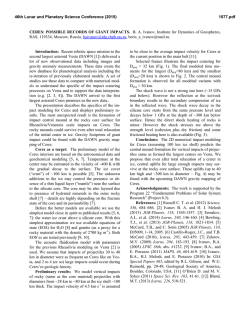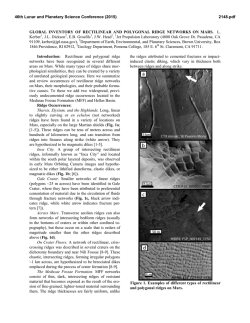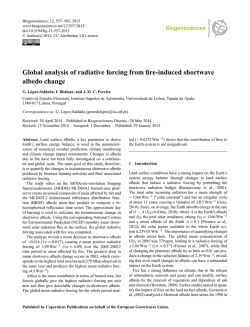
VIS-NIR Spectroscopy of Linear Features of Tectonic Origin on
46th Lunar and Planetary Science Conference (2015) 1469.pdf VIS-NIR SPECTROSCOPY OF LINEAR FEATURES OF TECTONIC ORIGIN ON VESTA AND OTHER ASTEROIDS. A.Longobardo1, E. Palomba1, M.C. De Sanctis1, F. Capaccioni1, F. Tosi1, J. Scully2, E. Ammannito2,1, F. Zambon1, C.A. Raymond3 and C.T. Russell2 1IAPS-INAF (via Fosso del Cavaliere 100 00133 Rome, [email protected]), 2UCLA, Institute of Geophysics, CA, USA, 3JPL, California Inst. Techn., Pasadena, CA, USA Introduction: The NASA Dawn spacecraft orbited the (4) Vesta asteroid for more than one year [1,2], strongly improving our knowledge of the asteroid. In particular, multi and hyperspectral images of Vesta have been provided by the Framing Camera (FC) [3] and by the Visible and InfraRed spectrometer (VIR), [4], respectively, and surface elemental composition maps have been obtained by the Gamma Ray and Neutron Detector (GRaND) [5]. The Vesta visible and near-infrared spectra provided by VIR are dominated by the two pyroxene bands, centred at approximately 0.9 m and 1.9 m. This is a confirmation of HED composition of Vesta surface [6,7], as already inferred from ground-based observations (e.g. [8]). In this work we focus on the linear features of tectonic origin found on the Vesta surface, and analyze their spectral properties. In particular we look for variations of spectral parameters in correspondence of the features. This would help to characterize linear features by means of spectral analyses in the following studied of asteroid surfaces. The spectral parameters considered are band centers (i.e. band minima after the continuum removal) and depths (i.e. 1-Rb/Rc, where Rb and Rc are the reflectance level and the continuum at the band center). Band depths have been photometrically corrected by applying the empirical correction by [9]. Moreover, albedo [9] and Clementine color ratio [10] maps have been considered, too. Linear features: Most of the linear features found on the Vesta surface have been generated by the Rheasilvia impact [11]. This impact is thought to have occurred 1 Gyr ago [11] and formed the Rheasilvia basin near the South Pole, as well as a series of troughs and horsts (parallel to the basin) in the equatorial region. The longest trough is the Divalia Fossae, extending from 11°S to 7°S latitudes and from 10°E to 90°E longitudes. According to the fault displacement analysis [12], these troughs consist in graben, i.e. block of land being downthrown producing a valley with a distinct scarp on each side. A similar set of graben is the Saturnalia Fossae Formation, extending at latitudes between 18°N and 40°N and longitudes between 239°E and 285°E. The orientation of these graben suggests that they have been generated by the Veneneia impact, thought to have occurred 4 Gyr ago [12]. However, other linear features can be observed on Vesta. Grooves, i.e. chains of secondary materials ejected from impacts [13], are the most common linear features on asteroids. They form preferably on undifferentiated asteroids, since the different composition between mantle and crust favors the formation of graben rather than grooves [12,13]. However, they are also found on Vesta near the Publicia (15°N 84°E) and Calpurnia (35°N 200°E) craters. Ridges, i.e. chains of elevated regions forming a crest, are mostly observed in the Southern hemisphere, eastwards of 180°E, but also in the equatorial region. Finally, fractures, i.e. crust breaks, are observed at equatorial latitudes and eastern longitudes. Results: The maps of the various spectral parameters considered (including albedo and color) do not show significant variations in correspondence of graben, independently of their age. As a matter of fact, Divalia Fossae (Figure 1) and Saturnalia Fossae formations show a similar behavior. Figure 1. FC observation (left) and VIR albedo map at 1.2 m (right) [9] of equatorial troughs (indicated by the red arrows) in the Divalia Fossa Formation. Latitude spans from 19°S to 0° and longitude from 75°E to 94°E The lack of spectral signatures is compatible with the formation mechanisms of graben. Graben and horsts are in fact generated from the same block of land and, even after the fault, experience the same geological history. However, we cannot exclude that scarps have a composition different than graben and horts, since they were cut down through the sub-surface and hence should have a composition similar to sub-surface rather than to surface. Anyway, scarps appear to be spectrally and optically similar to the graben, and this 46th Lunar and Planetary Science Conference (2015) can be due either to the VIR spatial resolution not sufficient to observe them or to their resurfacing by regolith. A decrease in albedo is instead observed in correspondence of grooves. This can be ascribed to their different composition with respect to the surroundings. This is found also on other asteroids. For example, on Eros grooves show an albedo lower than surrounding terrains [14]. A spectral analysis of grooves has been performed also on Lutetia, by combining the VIRTIS-Rosetta data [15] and the geological maps given by [16,17]. Also in this case the grooves in the Achaia region show an albedo different (in this case larger) than the surroundings (Figure 2). 1469.pdf also on the Lutetia surface. In addition, this result is confirmed by previous studies on the Eros surface. Similarly to graben, ridges also do not present albedo or composition variations. However, they can be discerned by graben, since are bluer than the surroundings, probably due to the fact that they are composed of fresher materials. Figure 3. Clementine color ratio of the Vesta ridges located at 50°S-66°S latitudes and 310°E-350°E longitudes overimposed on the Vesta FC map. Figure 2. Azimuthal albedo map at 1.2 m of Lutetia. The groove in the Achaia region is highlighted by red arrows. An albedo variation is also observed in correspondence with fractures, which in principle sample deeper in the crus, thereby showing a composition different than the upper crust. Finally, ridges are not associated to albedo or band depth changes, as graben. However, they are well defined in the Clementine ratio maps, differently than graben. In particular, a visible spectral slope decrease in correspondence of ridges is observed, hence ridges are bluer than surroundings (Figure 3). The most plausible explanation for the blue color of ridge materials can be ascribed to the fact that they are fresher. Conclusions: The comparative analysis performed in this work identified how the different linear features of tectonic origin appears in spectral maps. Graben are the only linear features which do not show spectral variations. Otherwise, grooves and fractures are associated to albedo variations, due to their composition different than the surroundings, i.e. secondary material ejected by impacts in the first case and subsurface material in the latter case. This has been observed not only on different regions on Vesta, but References: [1] Russell, C.T. et al. (2012), Science, 1-14 [2] Russell, C.T. et al. (2013), MAPS, 1-14, doi: 10.1111/maps.12091. [3] Sierks, H. et al. (2011), SSR, 163, 263-327 [4] De Sanctis, M.C. et al. (2011), SSR, 163, 329-369 [5] Prettyman, T.H. et al. (2011), SSR, 163, 371-459. [6] De Sanctis M.C. et al. (2012), Science, 336, 6082, 697-700 [7] De Sanctis, M.C. et al. (2013), MAPS, doi: 10.1111/maps.12138. [8] McCord, T.B. et al. (1970), Science, 168, 3938, 1445-1447 [9] Longobardo A. et al. (2014), Icarus, doi: 10.1016/j.icarus.2014.02.014 [10] Pieters, C.M. et al. (1994), Science, 266, 5192, 1844-1848. [11] McSween, H.Y. et al. (2013), JGR, 118, 2, 335-346. [12] Buczkowski D.L. et al. (2012), Icarus, 193, 39-52 [13] Scully, J. et al. (2014), Icarus, 244, 23-40. [14] Prockter, L.P. et al. (2002), Icarus, 155, 75-93. [15] Coradini, A. et al. (1999), Adv. Spa. Res., 24, 9, 10951104. [16] Massironi, M. et al. (2012), PSS, 66, 1, 125136. [17] Thomas, N. et al (2012), PSS, 66, 1, 96-124 Acknowledgements: VIR is funded by the Italian Space Agency–ASI and was developed under the leadership of INAF-IAPS. The instrument was built by Selex-Galileo, Florence-Italy. The authors acknowledge the support of the Dawn Science, Instrument, and Operations Teams. This work was supported by ASI and NASA.
© Copyright 2026
